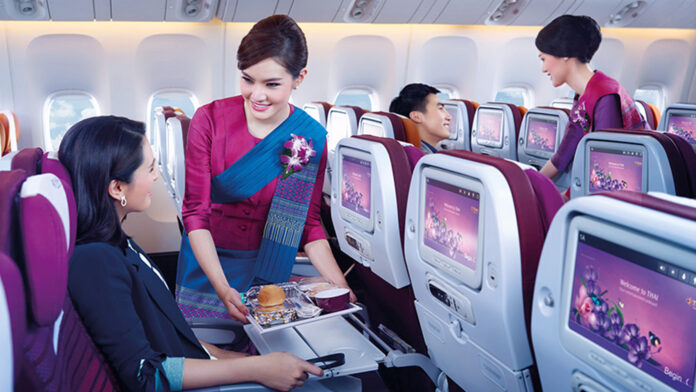Access selected deals available with budget and full-service airlines
Lock any airfare that sounds great. You don’t lose anything if you cancel it
Call us anytime for any assistance. We do not go into hibernation
Your personal and financial information stays secure with us
Thai Airways International Public Company Limited (THAI), Thailand’s flag carrier, is renowned for its exceptional service, cultural hospitality, and extensive global network. Founded in 1960 and headquartered in Bangkok, THAI operates from its primary hub at Suvarnabhumi Airport (BKK) and a secondary hub at Phuket International Airport (HKT). As a founding member of Star Alliance, THAI serves over 60 destinations in 30 countries across Asia, Europe, North America, and Australia, carrying approximately 24 million passengers annually. With a modern fleet of Airbus and Boeing aircraft, THAI emphasizes premium inflight experiences, sustainability, and Thai culture. Despite accolades, including Skytrax’s World’s Best Airline Cabin Crew in 2024, THAI faces challenges with financial restructuring, customer service delays, and operational disruptions. Following a 2020 bankruptcy filing, THAI is implementing a rehabilitation plan, targeting profitability by 2025.

Thai Airways International was established on March 29, 1960, through a partnership between the Thai government (51%) and Scandinavian Airlines System (SAS) (49%), combining Thai Airways Company’s domestic operations with SAS’s international expertise. The airline’s first international flight, from Bangkok to Hong Kong, operated on May 1, 1960, using a Douglas DC-6B leased from SAS. In 1977, the Thai government acquired SAS’s stake, making THAI fully state-controlled. By 1988, THAI listed on the Stock Exchange of Thailand, with the Ministry of Finance holding a 53.77% stake as of 2025.
THAI expanded rapidly, introducing Boeing 747s in 1977 and becoming a Star Alliance founding member in 1997, enhancing global connectivity. In 1998, THAI launched its Royal Orchid Plus (ROP) frequent flyer program. The airline modernized with Airbus A380s in 2012 and Boeing 787s in 2014, serving key routes like Bangkok–London and Tokyo. By 2015, THAI employed over 20,000 staff and carried 24.57 million passengers with a 70.1% load factor.
Financial challenges emerged in the 2010s, with losses reaching $1.2 billion by 2019 due to high operating costs, an oversized fleet, and competition from low-cost carriers. In May 2020, THAI filed for bankruptcy protection under Thailand’s Central Bankruptcy Court, initiating a rehabilitation plan with $2.2 billion in debt restructuring. The plan reduced the fleet from 103 to 67 aircraft, cut 50% of staff, and secured 25 billion THB in loans. By December 2024, THAI reported a 2.7 billion THB profit for Q3, projecting 10–12 billion THB for 2025, with plans to exit rehabilitation by Q2 2025. In January 2025, THAI resumed Airbus A380 services for Bangkok–Tokyo Narita and Osaka, reflecting recovery momentum.
As of June 2025, THAI operates a fleet of 67 aircraft, including 20 Airbus A320-200s, 6 Airbus A330-300s, 8 Airbus A350-900s, 6 Airbus A380-800s, 10 Boeing 777-200ERs, 9 Boeing 777-300ERs, 6 Boeing 787-8s, and 2 Boeing 787-9s, with an average age of 11 years. The A380s, reintroduced in 2025, feature 12 First Class suites, 60 Royal Silk Business Class seats, and 435 Economy seats. The A350-900s and 787s offer modern cabins with lie-flat Business seats and enhanced Economy comfort. THAI plans to acquire 45 Boeing 787-9s, with deliveries starting in 2027, to replace older 777s and A330s.
Sustainability is a priority, with THAI targeting carbon neutrality by 2050. The airline uses fuel-efficient A350s and 787s, reducing emissions by up to 25% compared to older models. In 2024, THAI operated Thailand’s first sustainable aviation fuel (SAF) flight, sourcing SAF from Neste and Shell. Initiatives like single-engine taxiing, waste recycling, and digital boarding passes further environmental goals. THAI Cargo, operating freighters and passenger aircraft bellies, supports economic sustainability, serving 30 destinations.